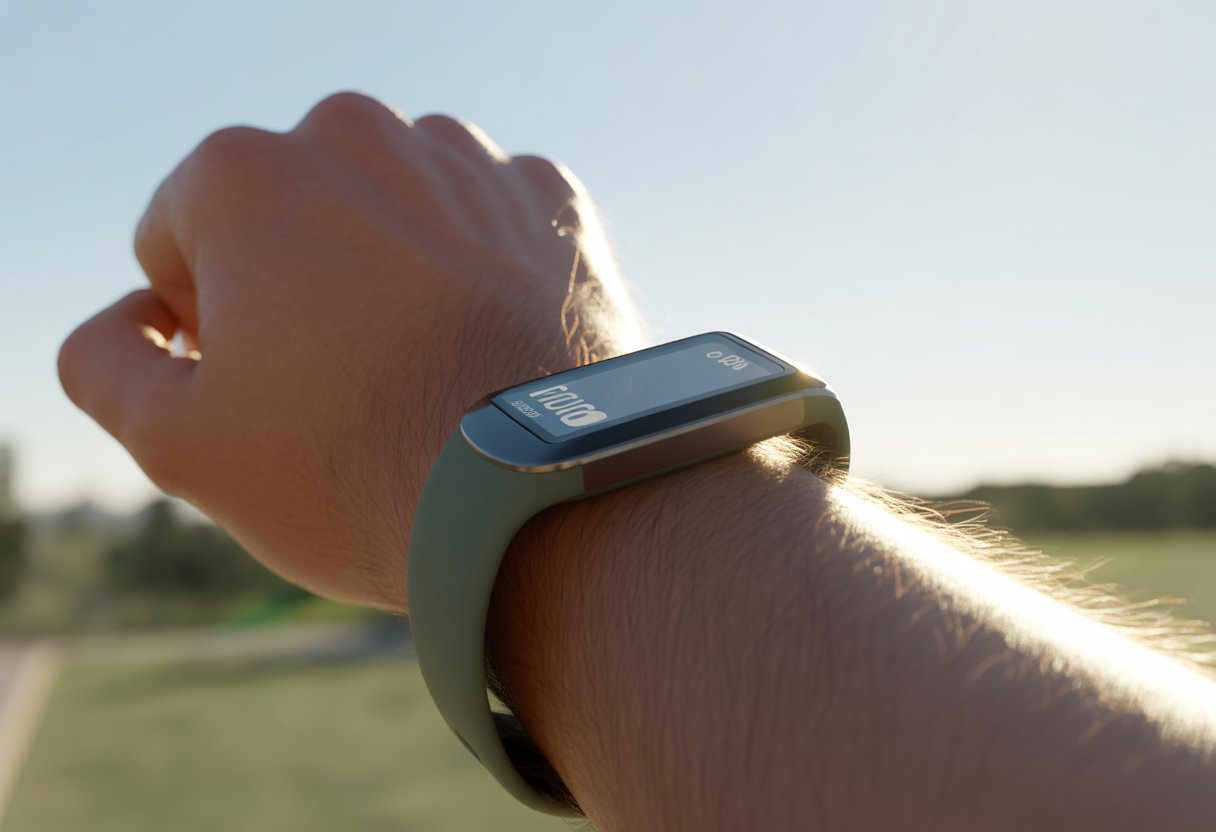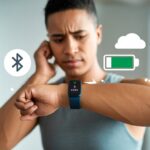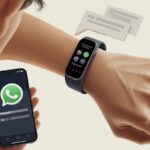Ever tried to check your fitness tracker after a good run in the park? Yeah, the struggle’s real: sunlight hits, and suddenly your fancy watch just becomes a shiny, useless wrist accessory. Fitness trackers often get hard to read in bright sunlight because most screens just aren’t built to fight off direct sun glare. It’s pretty much the tech version of squinting at your phone after it’s been at the beach all day—utterly hopeless.

We mess with the settings, tilt our wrists, maybe use our hand as a sunshade. Still, the screen stays annoyingly dim. If you’ve wondered why this happens or how to fix it, you’re definitely not alone.
Let’s dig into why glare ruins the fun and how to make reading your wearable a little less of a guessing game.
Why Sunlight Makes Your Fitness Tracker Display Vanish
Our trackers count steps like champs, but in sunlight, they just disappear. It’s not magic—just a battle between your device’s display and the sun, both fighting for your attention.
Understanding Ambient Light and Display Technology
Inside, your tracker’s screen looks crisp and clear. That’s because most screens rely on backlights and work best in gentle, indoor lighting.
Displays use different tech, and some types do better than others in sunlight.
Backlit LCDs depend on tiny lights inside the device. When sunlight blasts in, those little lights can’t compete.
OLED screens might be brighter, but even they struggle when the sun’s showing off. Some trackers use transflective displays—they bounce sunlight right back, so the screen stays readable. But let’s be honest, most of us don’t have those.
So whether you’re walking or just pretending to check the time, your screen and the sun are locked in a tug-of-war. Usually, the sun wins.
Direct Sunlight vs. Indoor Use
Indoor lighting? Easy. Your tracker happily shows off your steps, calories, and even that dentist reminder.
Step outside, and everything changes.
Direct sunlight is way brighter than any indoor bulb—sometimes a hundred times brighter. Your display tries to keep up by boosting brightness, but even at max, it can only do so much.
You end up cupping your hand, squinting, or tilting your wrist at some weird angle just to see your heart rate. Sometimes switching to manual brightness or finding some shade helps.
Otherwise, watching your tracker vanish in the sun becomes its own outdoor activity.
Why “Difficult to See Outside” Happens
Trackers want to help, but direct sunlight just overwhelms their little screens. It’s not just you—this happens to a lot of fitness trackers and smartwatches.
Some newer trackers have sensors for ambient light and try to adjust brightness automatically, but that’s not always enough.
When the sun’s out, the display’s light just gets buried. The screen looks faded or ghostly, and sometimes you can’t see anything unless you step into the shade.
A few trackers let you tweak display brightness or turn on a “sunlight mode.” But let’s be real—this is a common problem, and manufacturers basically shrug and say it’s just how electronics work outdoors.
If you want more, check out why some screens are difficult to see outside or how different tracker displays react to sunlight.
Troubleshooting Display Visibility Issues
When your fitness tracker screen looks ghostly or super dull in sunlight, you’ve still got options. A few quick tweaks might get your display shining again.
Adjusting Backlight Brightness
Honestly, your tracker doesn’t always get how bright it is outside. The backlight is your first defense.
Cranking up the brightness often makes a big difference.
Usually, you can do this in the Settings app under Brightness. Some trackers have an “auto” setting, but the sun doesn’t play fair, so manual adjustment is often smarter.
If you get multiple brightness levels, go for the brightest one—especially on those blinding afternoons.
For Fitbit Charge 3 or similar devices, this simple step can work wonders.
If it still doesn’t help, maybe it’s time for sunglasses… or a new gadget.
Checking Device Settings for Outdoor Mode
Tech companies love to hide useful features with mysterious names. A lot of fitness trackers have an Outdoor Mode or a special sunlight setting.
This mode tweaks the display for super-bright conditions.
Dig through your settings for anything called “Outdoor,” “Sunlight,” or “Daylight.” Some Garmin watches do better if you run manual brightness at 100%.
If your tracker has a gesture feature, make sure it wakes up when you tilt your wrist.
Otherwise, you’ll spend all your time squinting.
Quick checklist:
- Outdoor/Sunlight mode: On
- Gesture/wake: Enabled
- Auto brightness: Off (if it’s not working)
Flip the right switches before the sun wins again.
Cleaning Your Screen (And Your Conscience)
Before you panic about warranty claims, just wipe the screen. Sweat, sunscreen, and random fingerprints block light better than you’d think.
A microfiber cloth works best, but the edge of a clean shirt gets the job done in a pinch.
Regular cleaning helps with visibility and honestly, it keeps you looking less gross at the gym. For stubborn smudges, a tiny bit of water (never harsh cleaners!) is fine.
Don’t forget—using a clean screen is basically the grown-up version of checking your teeth before a date.
Oh No! It’s Still Not Working – What Else Could Be Wrong?
Sometimes, the sun isn’t your only enemy. Even if you fix the brightness, other issues like battery quirks, sneaky water, or hardware trouble can mess things up.
Battery and Battery Life Surprises
Let’s talk batteries. Some days they’re full of life, and other days they quit before you do.
A weak or old battery can make the screen dim, flicker, or just shut off—especially in bright light.
If you’re charging more often or the device dies randomly, your battery might be waving goodbye.
Check if battery saver modes are secretly dimming your screen. Extreme temps—hot or cold—can make battery performance even worse.
Keep an eye on battery health in your tracker’s settings. If it looks off, you might need a new battery—or maybe even a new tracker.
Compromised Water Resistance
Trackers love to go swimming when you least expect it. Even if it says water resistant, damage to the seals lets water sneak in.
Moisture can cause display glitches, weird spots, or a foggy screen.
Dropped your tracker in the sink or got caught in a rainstorm? Water damage might not show up right away.
Always check the band, charging port, and seals for moisture or dirt.
If the display acts up after getting wet, turn it off and let it dry completely. Still not working? You might need a pro—or at least a gentle hair dryer.
Display Hardware Problems
Sometimes, no matter how hard you squint, the screen just won’t cooperate.
The display hardware—LCD or OLED—might be faulty. You’ll see flickering, lines, dead pixels, or a screen that’s just stubbornly dark.
Some device displays just aren’t made for sunshine, but accidental drops or sitting on your tracker (hey, it happens) can make things worse.
If restarting and updating doesn’t help, and you’ve ruled out battery and water issues, it could be time for a repair or replacement.
At least it’s an excuse to shop for a new gadget, right?
Is It the Software? Blame It on the Code!
Sometimes, fitness trackers just glitch out—especially when the sun’s out. The culprit? Sometimes it’s the software, not the hardware.
Update Your Firmware and Apps
We all ignore update notifications. That “remind me later” button? Guilty.
But if your tracker gets weird, old firmware is often to blame.
Outdated software can make the screen glitch, freeze, or go dim—sometimes only outdoors. Updates bring bug fixes that help the device handle sunlight and avoid display bugs.
Check for firmware updates on your device or through the app on your Android phone or computer. Keep the tracking app itself up to date, too.
Turning on automatic updates means you won’t have to think about it again.
Trouble with Syncing to Your Android Phone or Computer
Trackers love to stay connected. If syncing with your phone or computer fails, display settings might not update.
Sometimes, a low brightness setting from your phone gets stuck if syncing doesn’t finish.
Syncing issues can also cause data errors, and your device might get confused about how bright the screen should be. You’ll probably notice this when you step outside and the screen suddenly becomes unreadable.
Restart both your tracker and phone, make sure Bluetooth’s on, and reconnect through the manufacturer’s app.
If things stay stubborn, uninstalling and reinstalling the app can sometimes set things straight.
Other Software Glitches
Let’s be real—software can pull some pretty random stunts. Sometimes, a display just decides to stop working right because some odd bug snuck into the code.
Some trackers point fingers at the ambient light sensor, which relies on software to do its job. If the code glitches, the screen has no clue when to brighten, and suddenly we’re squinting at our steps in the sun. Sometimes, the display just ignores our settings for no good reason.
If nothing else works, we might need a factory reset. This usually wipes out those rogue software gremlins, but don’t forget to back up your data first. It’s basically the “turn it off and on again” trick, just with extra drama.
Factors That Affect Outdoor Readability (Besides That Flaming Ball of Gas)
When our fitness tracker screens disappear in sunlight, it’s not always the sun’s fault. Sometimes, it’s just the little things—like a dirty screen or the type of display—that get in the way.
Protective Covers, Scratches, and Smudges
Let’s admit it, we slap screen protectors on everything these days—phones, tablets, even our activity trackers. But that extra layer can reflect light right back at us, making it harder to read our steps.
Tiny scratches scatter light across the screen, kind of like the display is wearing a shiny mask. And honestly, how often do we actually clean our screens? Oily fingerprints and dust can make a brand new display look old before lunch.
Here’s a tip: keep the screen clean and scratch-free if you want the best visibility. Use a soft microfiber cloth—not the bottom of your shirt.
Type of Display: OLED, LCD, and E-Ink
All screens are not built the same. OLED displays look gorgeous indoors, but they vanish into a ghostly shimmer outside. LCDs use backlighting, so the sun can overpower them, leaving our step count hiding in plain sight.
E-Ink displays, like the ones on e-readers, reflect sunlight like real paper. They’re not flashy, but they usually win when it comes to outdoor readability.
Here’s a quick breakdown of how these screens handle sunlight:
| Display Type | Outdoor Visibility | Color Quality |
|---|---|---|
| OLED | Low | High |
| LCD | Moderate | Good |
| E-Ink | High | Low |
Next time we’re squinting at our tracker, maybe it’s just the screen type making things tricky.
Outdoor Activities: Using Your Tracker in the Wild
Taking our fitness trackers outside? The sun isn’t just working on our tan—it’s also messing with our gadgets. Different features on our trackers react in weird ways once we’re in the wild.
Tracking Heart Rate and GPS Under the Sun
When we’re jogging, cycling, or just strutting around outside, our trackers rely on heart rate sensors and GPS. Sunlight can cause glare and make it impossible to read the display. If we can’t see the numbers, we end up staring at our wrist like we’re waiting for a secret code.
Bright sunlight sometimes confuses the heart rate sensors, which use light to measure our pulse. Sweat, sunscreen, and wild arm swings can block the sensors, so we get weird data—like a resting heart rate while we’re sprinting. GPS can get thrown off too, especially when trees or buildings join the chaos.
Quick Tip:
- Wipe the sensor clean.
- Try switching wrists for a better signal.
- Turn up brightness or find some shade.
Automatic Activity Detection Challenges
We expect our trackers to know when we’re moving. Outdoors, though, things get unpredictable. Sometimes, automatic activity detection thinks our wild arm flailing is “running,” or it logs a brisk walk as a nap.
Sunlight messes with touchscreens and sensors, so it might miss movements or count extra steps. Using hiking poles? The tracker might get even more confused. Suddenly, our “outdoor adventure” becomes ten minutes of “unknown wiggling.” Some devices try to auto-detect activity, but direct sun and bouncy moves make it less reliable.
What helps:
- Double-check after workouts.
- Log the activity manually if it misses something.
- Don’t blame the watch if your dance moves get logged as Zumba.
Pairing with Exercise Equipment and Compass Features
Pairing our tracker with treadmills or bikes outside? That’s always an adventure. Some trackers use Bluetooth or ANT+ to connect to gym equipment, but sunlight can make the display hard to read—even seeing a “paired!” icon becomes a guessing game.
The built-in compass can help us find north, but electromagnetic interference from phones, power lines, or big metal benches can throw it off. If we get lost in the park, maybe don’t blame the tracker. And if the compass points toward your friend’s house, maybe they’re just messing with you.
Key tips:
- Pair devices before heading outside.
- Use buttons if the touchscreen freaks out in the sun.
- If the compass goes wild, check for magnets or electronics nearby.
Other Mysterious Interferences (Spoiler: Laptops and Printers Not Involved)
When our tracker screens act up outdoors, it’s tempting to blame all the tech around us. But not every gadget is out to ruin our step count.
Nearby Tech Devices: Fact or Fiction?
Ever wondered if your laptop, Mac, or even a sneaky printer could mess with your tracker display? Honestly, almost never. Most trackers use Bluetooth or USB charging, and they don’t care about nearby computers.
Printers? Nope. More likely to jam paper than sabotage your fitness. Big electronics do send out signals, but not the kind that confuses your fitness watch in the sun.
The real problem? Bright sunlight and glare. Not your laptop, not the family printer, not even that unsaved Word doc.
Networking, Email, and the Microsoft Office Conspiracy
Wouldn’t it be wild if finishing a PowerPoint ruined your step count, or if Outlook sabotaged your run? Email and Office tools just work online—your fitness band ignores those data packets.
Wi-Fi routers fill the air with signals, but unless your tracker thinks it’s a router, it won’t care. Your screen isn’t blank because you used Excel to count your steps.
If anything, these programs just distract us from exercising. The real issue is sunlight, not some Office update.
When to Contact Support (Or Ponder Buying a New Activity Tracker)
Sometimes, our tracker just refuses to cooperate—especially in the sun. If we can’t see the display no matter what, it might be time to get expert help or look for a device with better outdoor skills.
Warranty and Service Tips
Let’s not go full mad scientist on our tracker in the sun. If brightness and restart tricks don’t help, check if your device is still under warranty. Most brands have a support website with warranty info and service request forms.
If the display looks super dim or flickers, it could be a hardware issue, not just sunlight. Contact support if you spot cracks, dead pixels, or the touchscreen stops responding. They might ask for photos or have you run quick tests. Here’s a quick checklist:
- Still have warranty? That’s free help.
- Screen unreadable indoors, too? Call support.
- Display cracked or broke after a swim? Call ASAP.
Worst case, they tell you to reboot. Best case, you get a free replacement or fast repair.
Choosing a Sunlight-Readable Device
Thinking about upgrading? Look for trackers with AMOLED or MIP (memory-in-pixel) screens—they usually shine outside. Apple Watches and some Garmin models get high marks for sunlight readability, while others struggle, as folks mention on the Fitbit Community.
Try demo models at a store if you can. Step outside—yes, really—and see how they look. Watch for terms like “sunlight visible,” “transflective display,” and “high brightness.” These clues help you find a device that won’t ghost you in daylight.
Honestly, if you’re squinting so hard you get new wrinkles, maybe it’s time to let go and grab a more readable tracker.
Final Thoughts: Should You Just Give Up and Go Live in a Cave?
We get it. Standing outside, squinting at your tracker in the sun, feels like some real-life boss battle.
Will the screen win, or will your eyes give up first? Some days, it’s honestly a toss-up.
But do you really need to give up and move into a cave—where, let’s be honest, fitness tracking just means counting cave spiders? Probably not.
Here’s a quick list of what you could try instead of embracing the cave life:
- Use your hand as a shade. Not exactly high-tech, but hey, it works… sometimes.
- Tilt the screen to dodge the glare. Feels a bit like you’re using some secret agent gadget.
- Try a tracker with a screen that’s actually visible in sunlight. Some watches are just easier to read outside.
| Challenge | Possible Fix |
|---|---|
| Sun glare | Find shade, adjust angle |
| Faint display | Increase brightness |
| Cave temptation | Go hiking instead |
If all else fails, just tell your friends you hit 10,000 steps—no one’s checking. For now, let’s skip the cave and keep fighting the sun, one squint at a time.
- How to connect Bluetooth headphones to a Chromebook Without Summoning Tech Support - December 15, 2025
- Best Fitness Trackers for EMS Workers: Because Your Heart Rate Isn’t the Only Thing Racing - December 15, 2025
- Why do my Bluetooth headphones not skip tracks? Tech tantrums and other musical mysteries - December 14, 2025






